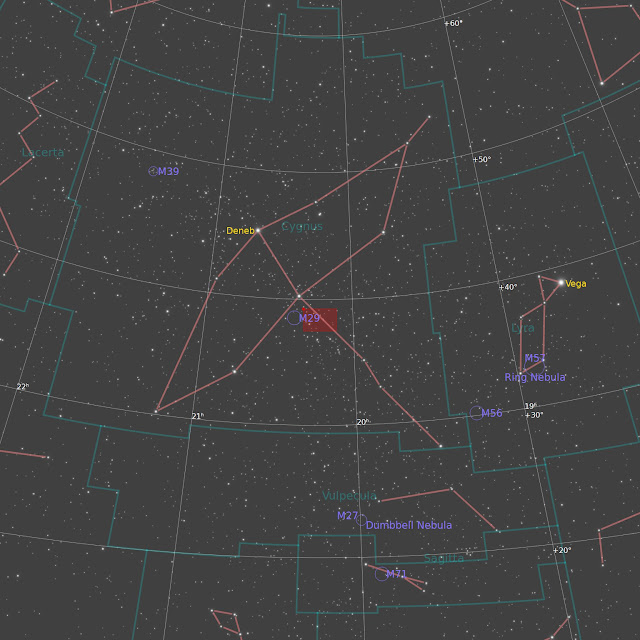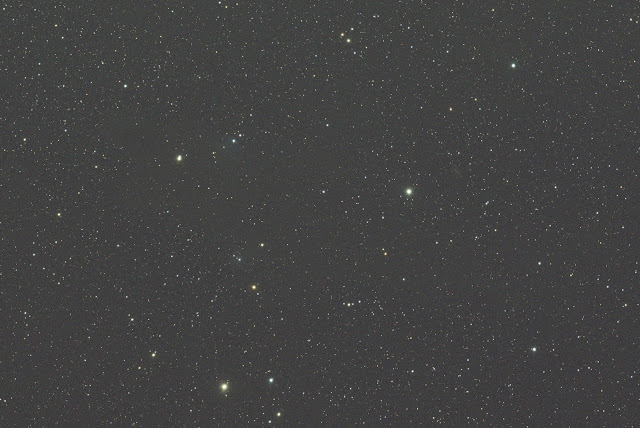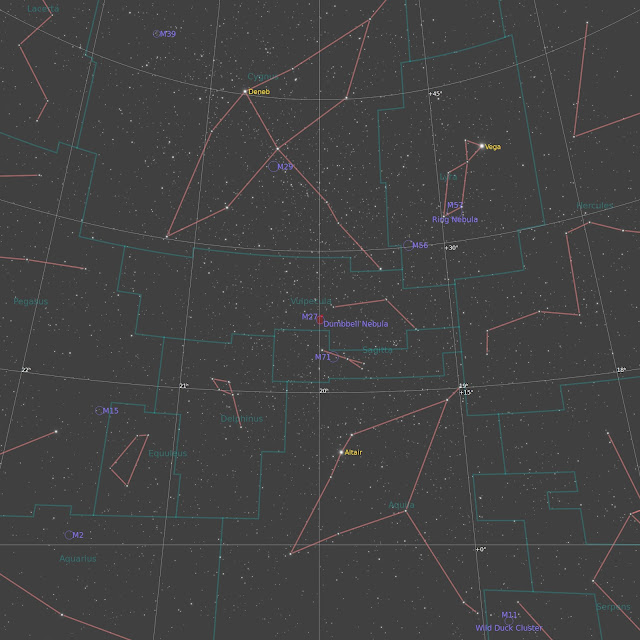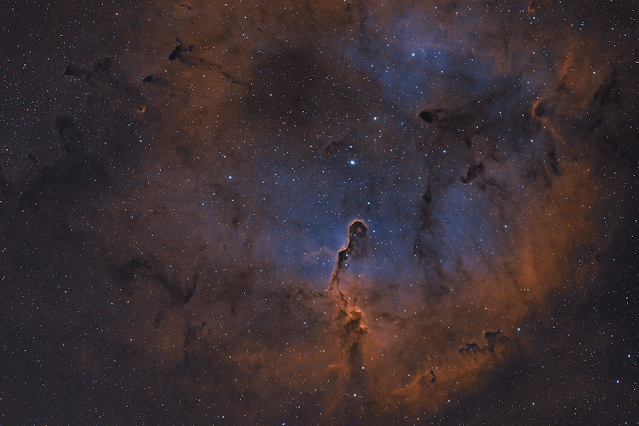A star went BOOM!
About 21 million years ago in the galaxy Messier 101, the Pinwheel Galaxy, a star went boom. It really went boom. Specifically, a Core Collapse Supernova known as a Type II Supernova, one of the most energetic events in the Universe. This particular supernova was first observed on May 19, 2023, by Koichi Itagaki. The Zwicky Transient Facility confirmed the discovery and found an image of the supernova (much fainter) from two days before the discovery observation.
 |
| A recent image of M 101 from before the supernova. |
Type II Supernova Facts
- This type of supernova occurs for stars at least 8 times more massive than our Sun and will leave behind a Neutron Star or Black Hole.
- Supernovae can outshine their host galaxies, releasing as much energy in a single burst as our Sun will release in 10 billion years.
- Many of the elements heavier than iron are created in this type of Supernovae.
- Supernovae produce a mind bogglingly large number of Neutrinos. In 10 seconds a core-collapse supernova will release 1058 neutrinos.
- Supernovae can accelerate particle to at least 1000 times the energy of particles in the Large Hadron Collider.
Good Timing
The timing of this event was favorable for observation by amateur astronomers in the northern hemisphere due to the following factors:
- M 101 is located just off the handle of the Big Dipper in the constellation Ursa Major.
- M 101 is a popular target for amateur astronomers, especially in the northern Hemisphere's spring, known to amateur astronomers as galaxy season.
- M101 is high in the sky, making it favorable for observation.
- Astronomically speaking, 21 million light years is "close" and therefore SN 2023ixf appears bright.
This event is for those of us located in the northern hemisphere, as M 101 is near the North Celestial Pole. Unfortunate news for our friends in the southern hemisphere. I don't feel too bad for them, as they have had their fair share of amazing events and amazing objects not accessible to those of us in the north.
 |
| A finder chart for finding M 101. |
My Observations:
Night 1 - Sunday May 21, 2023:
My first shot at SN 2023ixf was Sunday May 21st. The forecast was calling for clear skies. Unfortunately, the forecast was also calling for dense smoke because of the wildfires in Alberta, Canada. I set up well before dark and hoped for the best. As it got dark, the stars were slow to appear. I could make out the crescent Moon near the horizon in the west and Venus was visible a little higher in the western sky. About 10 minutes before 10 pm, I could see Arcturus followed by a few stars in the Big Dipper. The smoke was definitely impacting the visibility of the stars. I decided to connect to my guide camera and see polar alignment was possible, and it was successful. Followed this up by slewing the telescope to the south, to an object close to where the Meridian and Celestial Equator (Dec = 0) for PHD2 guiding calibration. Again, this was successful. With both tasks successful completed, it was time to go for the supernova. I recently imaged M 101 at the end of April (click
here). One of my sub exposures from that session was used to frame the target, this would capture the object in the same orientation, facilitating before and after comparisons. After slewing to M 101, rotating the camera to match the previous image, and performing an autofocus run, NINA started capturing the first image. SN 2023ixf was clearly visible in the resulting image, even though the galaxy details were subdued by the smoke. NINA continued to capture exposures, and SharpCap live stacked them. I don't have the writing skills to properly convey how exciting this was.
Prior to starting the image session, I connected to an impromptu Zoom meeting with members of our local astronomy club, the Buffalo Astronomical Association (BAA). I was joined by our Observatory Director and a member from a sister club in Rochester, NY (who also belongs to our club). This person maintains a very useful website on supernovae (click
here). It's a fantastic resource and I've used it for years before meeting him in person at our last club picnic.
A total of 26 Images were captured from 10:07 PM to 11:17 PM, when the conditions degraded, and it no longer made sense to continue. Exposures were 120 sec each at a Gain of 100 with an Offset of 50. The images were captured on my Home Setup:
- Telescope: Explore Scientific Essential Series ED80 Air Spaced Triplet
- Mount: Sky-Watcher EQ6-R Pro
- Camera: ZWO ASI2600MC Pro
- Filter: None
- Accessories: Pegasus Astro Pocket Power Box Advanced, ZWO EAF, ZWO ASI224MC, Explore Scientific Field Flattener, & Orion 50 mm Mini Guide Scope
- Software: NINA, PHD2, SharpCap, & PixInsight
 |
| Single 120 sec exposure. A screenshot from the capture software NINA. Only a screen (display) stretch applied, no other processing. Look how bright the supernova is compared to the galaxy. |
 |
| The live stacked image from SharpCap. This is a a total of 26 exposures at 120 sec each for a total exposure of 52 minutes. The image was saved with the display stretch and the plug-in NoiseXTerminaror was applied in PixInsight to reduce the noise in the image. |
 |
| The final processed image. A total of 22 exposures were used (the last 4 images captured were too severely degraded to use). The image was processed in PixInsight. |
Night 2 - Monday May 22, 2023:
The forecast was calling for clear skies and dense smoke. I headed out to the Buffalo Astronomical Association's observatory (Beaver Meadow Observatory) for our weekly imaging group session. The group is called the Tuesday Night Imagers, but "Tuesday" can be pretty much any day of the week. This week it was Monday. I set up my ZWO ASI2600MC Pro on the club's Tele Vue NP-101is and another member setup his ZWO ASI1600MM Pro on the club's Celestron 14" Edge HD Telescope. Both scopes sit atop an Astro Physics AP1200 mount in our main observatory. The club's Observatory Director is the leader of the Tuesday Night group. He was traveling, so another member and I were running the session in his place. We made a couple of critical errors which will make getting anything off of the 14'" scope a challenge. The first issue is the OAG prism wasn't properly lined up with the imaging camera's sensor. This resulted in a prominent shadow in the corner of the exposures. Compounding this error, we took flats at Bin 1, which does not match our light frames taken at Bin 2. There may be a way to salvage the data, but that will have to wait for another day.
In addition to running the Tuesday Night session in place of the group's leader, we had an unusually large turnout due to the excitement of the supernova. Unfortunately, the smoke was very dense. most left around 10:30 PM. The supernova was visible in exposures but hardly any detail of the galaxy. Two of us stayed behind to troubleshoot the shadow issue on the 14". We continued to take exposures. We experienced a brief window where the smoke was not so dense. We captured images in both scopes for about a half an hour. After which we shut everything down and went home.
 |
| BAA members setting up outside the observatory to observe/image the Supernova. |
 |
| The Moon and Venus |
 |
| Another view of the Moon and Venus |
 |
| The Moon and Venus over our (the BAA) newly acquired Sky shed Pod. |
 |
| A photo of the screen showing a single 120 sec exposure of from the NP-101is when the smoke briefly cleared. BAA Tuesday Night Imagers. |
 |
| A photo of the screen showing a 120 sec exposure from the 14" Edge HD. |
BAA Tuesday Night Imagers.
 |
| Processed image captured on the NP-101is. Image was processed in PixInsight. BAA Tuesday Night Imagers. |
Night 3 - Wednesday May 24, 2023
Conditions were much better on Wednesday May 24th. My scope (Home Setup) was still setup from Monday Night. I imaged from dark until about 1:30 AM, when I lost this object to a tree. Unfortunately, after processing the image, I accidentally deleted the raw data while moving files to a backup hard drive, as the hard drive on my imaging computer was getting full. Needless to say, I'm not pleased with myself about this mistake! This image was made from a total of 85 exposures at 120 seconds / Gain 100 / Offset 50 each for a total exposure of 2.8 hours. Processing was done in PixInsight.
Night 4 - Thursday May 25, 2023
Conditions were very good again on Thursday May 25, 2023. Another image from my home setup. I imaged from 9:52 PM until 1:27 AM. Conditions were good enough that I continued to image another target (while I slept) after losing M 101. That will be covered in a future post. As the Moon was getting brighter and setting later, I decided to back off on my exposure time from 120 seconds to 60 sec. This image was made from a total of 145 exposures at 60 sec / Gain 100 / Offset 50 for a total exposure of 2.4 hours.
Putting all together in a Movie/Animation
Starting with my image of M101 from 4/26 (before the Supernova), I Star Aligned the processed images from each night using PixInsight. Then cropped them with Dynamic Crop in PixInsight. Photoshop was used to add the markers, the text, and to create the animation. Each frame has a 2 second duration. I converted the animation from a GIF to a MP4 movie file. Hope you like the result.
So, What's Next?
SN 2023ixf will be visible for a few more weeks. It will slowly dim. Will probably try and capture some more data if time and weather allow. Our Observatory Director and the person from the Rochester club that maintains the supernova website both provided me with information on how to determine the magnitude of the Supernova from my images. I intend to sit down and learn how to do this. When, not sure. When I do figure it out, I'll make another post or amend this one.
Clear Skies!
Ernie





















































